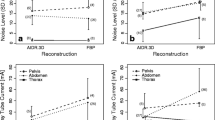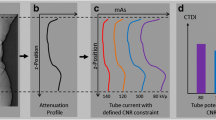Abstract
Coronary angiography and intervention can expose patients to high radiation dose. This retrospective study quantifies the patient dose reduction due to the introduction of a novel X-ray imaging noise reduction technology using advanced real-time image noise reduction algorithms and optimized acquisition chain for fluoroscopy and exposure in interventional cardiology. Patient, procedure and radiation dose data were retrospectively collected in the period August 2012–August 2013 for 883 patients treated with the image noise reduction technology (referred as “new system”). The same data were collected for 1083 patients in the period April 2011–July 2012 with a system using state-of-the-art image processing and reference acquisition chain (referred as “reference system”). Procedures were divided into diagnostic (CAG) and intervention (PCI). Acquisition parameters such as fluoroscopy time, volume of contrast medium, number of exposure images and number of stored fluoroscopy images were collected to classify procedure complexity. The procedural dose reduction was investigated separately for three main cardiologists. The new system provides significant dose reduction compared to the reference system. Median DAP values decreased for all procedures (p < 0.0001) from 172.7 to 59.4 Gy cm2, for CAG from 155.1 to 52.0 Gy cm2 and for PCI from 229.0 to 85.8 Gy cm2 with reduction quantified at 66, 66 and 63 %, respectively. Based on median values, the dose reduction for all procedures was 68, 60 and 67 % for cardiologists 1, 2 and 3, respectively. The X-ray imaging technology combining advanced real-time image noise reduction algorithms and anatomy-specific optimized fluoroscopy and cine acquisition chain provides 66 % patient dose reduction in interventional cardiology.


Similar content being viewed by others
References
Trianni A, Chizzola G, Toh H, Quai E, Cragnolini E, Bernardi G, Proclemer A, Padovani R (2005) Patient skin dosimetry in haemodynamic and electrophysiology interventional cardiology. Radiat Prot Dosimetry 117(1–3):241–246
Kaneko H, Yajima J, Oikawa Y, Tanaka S, Fukamachi D, Suzuki S, Sagara K, Otsuka T, Matsuno S, Funada R, Kano H, Uejima T, Koike A, Nagashima K, Kirigaya H, Sawada H, Aizawa T, Yamashita T (2014) Impact of aging on the clinical outcomes of Japanese patients with coronary artery disease after percutaneous coronary intervention. Heart Vessels 29(2):156–164
Picano E, Santoro G, Vano E (2007) Sustainability in the cardiac cath lab. Int J Cardiovasc Imaging 23(2):143–147
Fazel R, Krumholz HM, Wang Y, Ross JS, Chen J, Ting HH, Shah ND, Nasir K, Einstein AJ, Nallamothu BK (2009) Exposure to low-dose ionizing radiation from medical imaging procedures. N Engl J Med 361(9):849–857
Strauss KJ, Kaste SC (2006) The ALARA (as low as reasonably achievable) concept in pediatric interventional and fluoroscopic imaging: striving to keep radiation doses as low as possible during fluoroscopy of pediatric patients—a white paper executive summary. Pediatr Radiol 36(2):110–112
Dekker LRC, van der Voort PH, Simmers TA, Verbeek XAAM, Bullens RWM, van’t Veer M, Brands PJM, Meijer A (2013) New image processing and noise reduction technology allows reduction of radiation exposure in complex electrophysiologic interventions while maintaining optimal image quality: A randomized clinical trial. Heart Rhythm 10(11):1678–1682
Soderman M, Mauti M, Boon S, Omar A, Marteinsdóttir M, Andersson T, Holmin S, Hoornaert B (2013) Radiation dose in neuroangiography using image noise reduction technology: a population study based on 614 patients. Neuroradiology 55:1365–1372
Söderman M, Holmin S, Andersson T, Palmgren C, Babić D, Hoornaert B (2013) Clinical results with an image noise reduction algorithm for digital subtraction angiography. Radiology 269(2):553–560
Racadio J, Strauss K, Abruzzo T, Patel M, Kukreja K, Johnson N, den Hartog M, Hoornaert B, Nachabe R (2014) Significant dose reduction for pediatric digital subtraction angiography without impairing image quality: preclinical study in a piglet model. Am J Roentgenol 203:904–908
Farshid A, Chandrasekhar J, McLean D (2014) Benefits of dual-axis rotational coronary angiography in routine clinical practice. Heart Vessels 29(2):199–205
Ogita M, Sakakura K, Nakamura T, Funayama H, Wada H, Naito R, Sugawara Y, Kubo N, Ako J, Momomura S (2012) Association between deteriorated renal function and long-term clinical outcomes after percutaneous coronary intervention. Heart Vessels 27(5):460–467
Matejka J, Varvarovsky I, Vojtisek P, Herman A, Rozsival V, Borkova V, Kvasnicka J (2010) Prevention of contrast-induced acute kidney injury by theophylline in elderly patients with chronic kidney disease. Heart Vessels 25(6):536–542
Grantham JA, Marso SP, Spertus J, House J, Holmes DR Jr, Rutherford BD (2009) Chronic total occlusion angioplasty in the United States. JACC Cardiovasc Interv 2(6):479–486
Tsapaki V, Kottou S, Vano E, Faulkner K, Giannouleas J, Padovani R, Kyrozi E, Koutelou M, Vardalaki E, Neofotistou V (2003) Patient dose values in a dedicated Greek cardiac centre. Br J Radiol 76:726–730
Pantos I, Patatoukas G, Katritsis DG, Efstathopoulos E (2009) Patient radiation doses in interventional cardiology. Curr Cardiol Rev 5(1):1–11
Bar O, Maccia C, Pagès P, Blanchard D (2008) A multicentre survey of patient exposure to ionising radiation during interventional cardiology procedures in France. Euro Interv 3(5):593–599
Cui Y, Zhang H, Zheng J, Yang X, Liang C (2013) An investigation of patient doses during coronary interventional procedures in China. Radiat Prot Dosim 156(3):296–302
Bogaert E, Bacher K, Lemmens K, Carlier M, Desmet W, De Wagter X, Djian D, Hanet C, Heyndrickx G, Legrand V, Taeymans Y, Thierens H (2009) A large-scale multicentre study of patient skin doses in interventional cardiology: dose-area product action levels and dose reference levels. Br J Radiol 82(976):303–312
Sadick V, Reed W, Collins L, Sadick N, Heard R, Robinson J (2010) Impact of biplane versus single-plane imaging on radiation dose, contrast load and procedural time in coronary angioplasty. Br J Radiol 83(989):379–394
Tsapaki V, Ahmed NA, AlSuwaidi JS, Beganovic A, Benider A, BenOmrane L, Borisova R, Economides S, El-Nachef L, Faj D, Hovhannesyan A, Kharita MH, Khelassi-Toutaoui N, Manatrakul N, Mirsaidov I, Shaaban M, Ursulean I, Wambani JS, Zaman A, Ziliukas J, Zontar D, Rehani MM (2009) Radiation exposure to patients during interventional procedures in 20 countries: initial IAEA project results. AJR Am J Roentgenol 193(2):559–569
Rehani MM, Frush DP, Berris T, Einstein AJ (2012) Patient radiation exposure tracking: worldwide programs and needs–results from the first IAEA survey. Eur J Radiol 81(10):968–976
Thomsen HS, Morcos SK (2003) Contrast media and the kidney: european Society of Urogenital Radiology (ESUR) Guidelines. Br J Radiol 76:513–518
Davidson C, Stacul F, McCullough PA, Tumlin J, Adam A, Lameire N, Becker CR, CIN Consensus Working Panel (2006) Contrast medium use. Am J Cardiol 98(6):42–58
Conflict of interest
M. Mauti, Y. Waizumi and S. Yamada are employees of Philips Healthcare.
Author information
Authors and Affiliations
Corresponding author
Electronic supplementary material
Below is the link to the electronic supplementary material.
Rights and permissions
About this article
Cite this article
Nakamura, S., Kobayashi, T., Funatsu, A. et al. Patient radiation dose reduction using an X-ray imaging noise reduction technology for cardiac angiography and intervention. Heart Vessels 31, 655–663 (2016). https://doi.org/10.1007/s00380-015-0667-z
Received:
Accepted:
Published:
Issue Date:
DOI: https://doi.org/10.1007/s00380-015-0667-z




